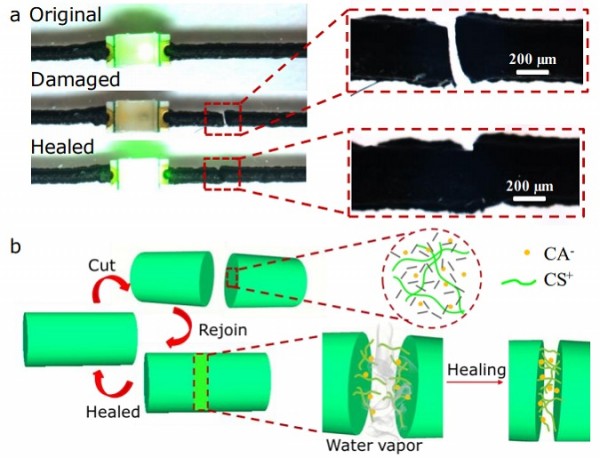In Kanada hat eine Gruppe von Forschern ein Kompositmaterial erzeugt, das sich bei Raumtemperatur und mit Wasserdampf selbst reparieren kann. Zudem wird das Material mit 3D-Druckern verarbeitet.
Eine Gruppe von Forschern des Research Center for High Performance Polymer and Composite Systems (CREPEC) an der Polytechnique Montréal hat ein neuartiges Kompositmaterial erschaffen. Das Material besteht aus Nanoröhrchen und Chitosan, ist elektrisch leitfähig und kann sich selbst reparieren. Ebenfalls ist das Material stark dehnbar. Der Reparaturprozess geht dabei relativ schnell, innerhalb einiger Sekunden.
Für ein solches Material gibt es viele potentielle Anwendungen. Möglich wäre der Einsatz in der Medizin, für Roboter (zB: künstliche Haut), tragbare Sensoren und viele weitere Bereiche.
Das neu entwickelte Material ist Flüssigkeit, das aktuell nur mit speziellen Druckverfahren verarbeitet werden kann. Wenn ein so gedrucktes Objekt durchgeschnitten wird, anschließend mit Wasser befeuchtet wird und dann getrocknet wird, geschieht folgendes: Da das Material Strom leitet, kann ein Vergleich angestellt werden, ob die Leitfähigkeit nach der „Reparatur“ gleich wie zuvor ist. Im Experiment war das der Fall, das gedruckte Objekt hat sich also vollständig regeneriert, obwohl es komplett durchtrennt wurde.
In Canada, a group of researchers has produced a composite material that can self-repair at room temperature and with water vapor. In addition, the material is processed with 3D printers.
A group of researchers from the Research Center for High Performance Polymer and Composite Systems (CREPEC) at Polytechnique Montréal has created a novel composite material. The material consists of nanotubes and chitosan, is electrically conductive and can repair itself. In addition the material is very elastic. The repair process is relatively fast, within a few seconds.
There are many potential applications for such a material. It would be possible to use it in medicine, for robots (eg: artificial skin), portable sensors and many other areas.
The newly developed material is liquid that can currently only be processed with special printing processes. When an object printed in this way is cut through, then moistened with water and then dried, the following happens: Since the material conducts current, a comparison can be made as to whether the conductivity after the „repair“ is the same as before. In the experiment that was the case, so the printed object has completely regenerated, although it has been completely severed.
Source: https://3druck.com/forschung/3d-gedrucktes-nanokomposit-kann-sich-selbst-reparieren-1177011/

